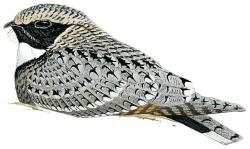| Common Poorwill | |
|---|---|
 Male | |
| Information | |
| Range | British Columbia and southeastern Alberta, through the western United States to northern Mexico. |
| Scientific Classification | |
| Kingdom | Animalia |
| Phylum | Chordata |
| Class | Aves |
| Order | Caprimulgiformes |
| Family | Caprimulgidae |
| Genus | Phalaenoptilus |
| Species | Phalaenoptilus nuttallii |
| Conservation Status | |
 Least Concern | |
The Common poorwill (Phalaenoptilus nuttallii), is a species of nightjar of the Caprimulgidae family. It is found from British Columbia and southeastern Alberta, through the western United States to northern Mexico. The bird's habitat is dry, open areas with grasses or shrubs, and even stony desert slopes with very little vegetation.
Many northern birds migrate to winter within the breeding range in central and western Mexico, though some remain further north. Remarkably, the common poorwill is the only bird known to go into torpor for extended periods (weeks to months). This happens on the southern edge of its range in the United States, where it spends much of the winter inactive, concealed in piles of rocks. Such an extended period of torpor is close to a state of hibernation, not known among other birds.
Taxonomy[]
The genus name Phalaenoptilus is a compound of Greek phalaina, moth and ptilon, feather. The species name nuttallii honors English-born American ornithologist Thomas Nuttall.
Description[]
This is the smallest North American nightjar, about 18 centimetres (7.1 in) in length, with a wingspan of approximately 30 centimetres (12 in). It weighs 36–58 grams (1.3–2.0 oz). The sexes are similar, both gray and black patterned above. The outer tail-feathers are tipped with white, the markings slightly more prominent in the male.
The common poorwill is told from similar nightjars by its small size, short bill, rounded wings with tips that reach the end of the short tail at rest, and pale gray coloration. Like many other nightjars, the common name derives from its call, a monotonous poor-will given from dusk to dawn. At close range a third syllable of the call may be heard, resulting in a poor-will-low. It also gives a chuck note in flight.
Behavior[]
The common poorwill is the only bird known to go into torpor for extended periods (weeks to months). This happens on the southern edge of its range in the United States, where it spends much of the winter inactive, concealed in piles of rocks. This behavior has been reported in California and New Mexico. Such an extended period of torpor is close to a state of hibernation, not known among other birds. It was described definitively by Dr. Edmund Jaeger in 1948 based on a poorwill he discovered hibernating in the Chuckwalla Mountains of California in 1946.
In 1804, Meriwether Lewis observed hibernating common poorwills in North Dakota during the Lewis and Clark Expedition. Though these observations were recorded carefully in Lewis's journal, their significance was not understood. This was at least in part because the common poorwill was not then recognized as a species distinct from the whip-poor-will of eastern North America. Native Americans of the Hopi tribe were likely aware of the poorwill's behavior even earlier — the Hopílavayi name of this bird, hölchko, means "The Sleeping One".
Subspecies[]
Up to five subspecies are described, although these are all quite similar, and some may be of dubious validity.
| Name | |
|---|---|
 |
Phalaenoptilus nuttallii adustus (Sonoran Poorwill) |
| Is paler and browner than the nominate race. It occurs from extreme southern Arizona to central Sonora. | |
 |
Phalaenoptilus nuttallii californicus (Dusky Poorwill) |
| Is darker and browner than the nominate race. It occurs in western California. | |
 |
Phalaenoptilus nuttallii dickeyi (San Ignacio Poorwill) |
| Is smaller and less heavily marked than californicus. It is resident in Baja California. | |
 |
Phalaenoptilus nuttallii hueyi (Desert Poorwill) |
| Is paler than the nominate race. It occurs in southern California. | |
 |
Phalaenoptilus nuttallii nutalli |
| It breeds over most of the North American range. |
